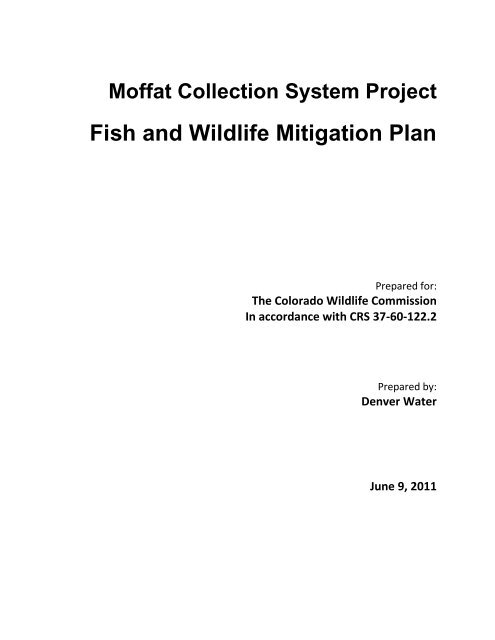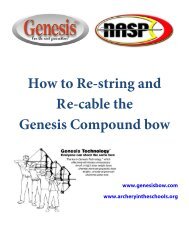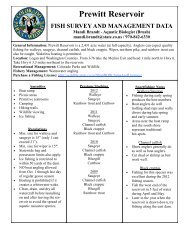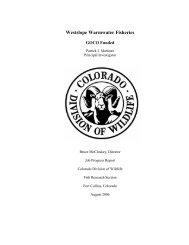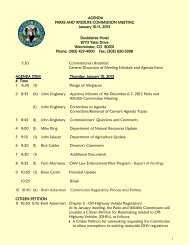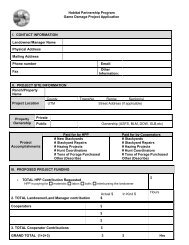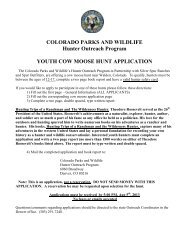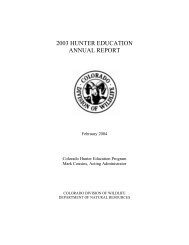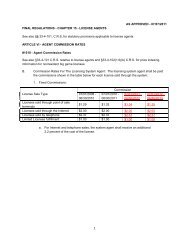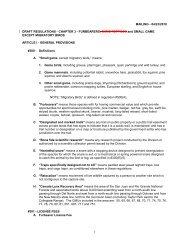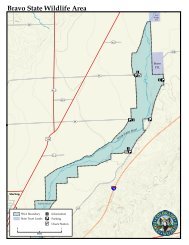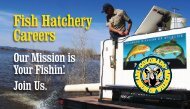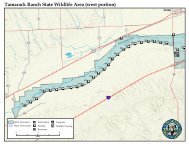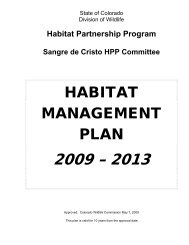Moffat Collection System Project - Mitigation Plan 6-9-11 - Colorado ...
Moffat Collection System Project - Mitigation Plan 6-9-11 - Colorado ...
Moffat Collection System Project - Mitigation Plan 6-9-11 - Colorado ...
You also want an ePaper? Increase the reach of your titles
YUMPU automatically turns print PDFs into web optimized ePapers that Google loves.
<strong>Moffat</strong> <strong>Collection</strong> <strong>System</strong> <strong>Project</strong><br />
Fish and Wildlife <strong>Mitigation</strong> <strong>Plan</strong><br />
Prepared for:<br />
The <strong>Colorado</strong> Wildlife Commission<br />
In accordance with CRS 37-60-122.2<br />
Prepared by:<br />
Denver Water<br />
June 9, 20<strong>11</strong>
EXECUTIVE SUMMARY<br />
1.0 INTRODUCTION<br />
Table of Contents<br />
1.1. <strong>Project</strong> Overview<br />
1.2. Regulatory Process<br />
1.3. Fish and Wildlife <strong>Mitigation</strong> <strong>Plan</strong> Stakeholders<br />
1.4. Concurrent and Related Activities<br />
2.0 AVOIDANCE AND MINIMIZATION<br />
3.0 FISH AND WILDLIFE MITIGATION<br />
3.1. West Slope<br />
3.1.1. Fraser and Upper Williams Fork Rivers<br />
3.1.2. <strong>Colorado</strong> River<br />
3.1.3. Blue River<br />
3.2. East Slope<br />
3.2.1. Gross Reservoir<br />
3.2.2. South Boulder Creek<br />
3.2.3. North Fork South Platte River<br />
3.2.4. South Platte River<br />
4.0 COST AND SCHEDULE<br />
5.0 CONCLUSION<br />
Tables<br />
1 Proposed <strong>Mitigation</strong> – Fraser River<br />
2 Proposed <strong>Mitigation</strong> – Williams Fork River<br />
3 Proposed <strong>Mitigation</strong> – <strong>Colorado</strong> River<br />
4 Proposed <strong>Mitigation</strong> – Gross Reservoir<br />
5 Proposed <strong>Mitigation</strong> – South Boulder Creek<br />
6 Proposed <strong>Mitigation</strong> – North Fork South Platte River<br />
7 Proposed <strong>Mitigation</strong> – South Platte River<br />
Figure<br />
Water <strong>Collection</strong> <strong>System</strong>
EXECUTIVE SUMMARY<br />
The City and County of Denver, acting by and through its Board of Water<br />
Commissioners (Denver Water) is proposing to construct the <strong>Moffat</strong> <strong>Collection</strong> <strong>System</strong><br />
<strong>Project</strong> (<strong>Moffat</strong> <strong>Project</strong>), a project designed to provide 18,000 acre-feet (AF) per year of<br />
new water supply to Denver Water’s customers. Denver Water proposes to enlarge its<br />
existing 42,000-AF Gross Reservoir, which is located in Boulder County, <strong>Colorado</strong><br />
approximately 35 miles northwest of Denver and 6 miles southwest of the city of<br />
Boulder. The purpose of this Fish and Wildlife <strong>Mitigation</strong> <strong>Plan</strong> (FWMP) for the <strong>Moffat</strong><br />
<strong>Project</strong> is to comply with the requirements of <strong>Colorado</strong> state law (CRS 37-60-122.2), as<br />
implemented by the procedural rules for the <strong>Colorado</strong> Wildlife Commission.<br />
The <strong>Moffat</strong> <strong>Project</strong> must comply with the National Environmental Policy Act (NEPA) by<br />
preparing an Environmental Impact Statement (EIS) and the Clean Water Act by<br />
applying for a Section 404 Permit from the U.S. Army Corps of Engineers (Corps).<br />
Denver Water will also apply to the Federal Energy Regulatory Commission (FERC) to<br />
amend its hydropower license for the Gross Reservoir hydroelectric facility.<br />
Denver Water is committed to comply with all mitigation measures in the FWMP, the<br />
Corps’ Record of Decision and Section 404 Permit, and the FERC license.<br />
Denver Water is also submitting a separate Fish and Wildlife Enhancement <strong>Plan</strong><br />
(Enhancement <strong>Plan</strong>) in cooperation with the Municipal Subdistrict of the Northern<br />
<strong>Colorado</strong> Water Conservancy District (Subdistrict), proposing to enhance fish and<br />
wildlife resources over and above current conditions in the <strong>Colorado</strong> River below the<br />
Windy Gap diversion.<br />
Since the Subdistrict is seeking approval through the state and federal regulatory<br />
processes for the WGFP concurrent with Denver Water’s <strong>Moffat</strong> <strong>Project</strong>, both Denver<br />
Water and the Subdistrict have agreed to cooperate in a process of simultaneous<br />
development of mitigation and enhancement plans pursuant to CRS 37-60-122.2.<br />
In addition to the required mitigation measures in the FWMP and voluntary<br />
enhancements in the Enhancement <strong>Plan</strong>, Denver Water and Grand County have<br />
reached a proposed agreement to provide environmental enhancements to benefit the<br />
aquatic environment in the Fraser, Williams Fork and Upper <strong>Colorado</strong> rivers, including<br />
participation in the cooperative effort called Learning by Doing (LBD).<br />
Denver Water will mitigate for environmental impacts of the <strong>Moffat</strong> <strong>Project</strong> through the<br />
measures identified in this FWMP. Additionally, Denver Water is proposing to improve<br />
the aquatic and riparian habitat of the <strong>Colorado</strong> River in Grand County with measures<br />
identified in the separate Enhancement <strong>Plan</strong> and the LBD Cooperative Effort. The<br />
FWMP, Enhancement <strong>Plan</strong>, and LBD Cooperative Effort are conditioned upon Denver<br />
Water improving the reliability of the <strong>Moffat</strong> <strong>Collection</strong> <strong>System</strong> water supplies through<br />
successful permitting of the <strong>Moffat</strong> <strong>Project</strong>. The LBD Cooperative Effort is only being<br />
offered to enhance existing conditions in Grand County and is not intended to reduce<br />
the amount of mitigation the U.S. Army Corps of Engineers (Corps) will require to<br />
mitigate the identified impacts of the <strong>Moffat</strong> <strong>Project</strong>.<br />
E-1
1.0 INTRODUCTION<br />
1.1 <strong>Project</strong> Overview<br />
The City and County of Denver, acting by and through its Board of Water<br />
Commissioners (Denver Water) is proposing to construct the <strong>Moffat</strong> <strong>Collection</strong> <strong>System</strong><br />
<strong>Project</strong> (<strong>Moffat</strong> <strong>Project</strong>), a water supply project designed to provide 18,000 acre-feet<br />
(AF) per year of new water supply to Denver Water’s customers. Denver Water<br />
proposes to enlarge its existing 42,000-AF Gross Reservoir, which is located in Boulder<br />
County, <strong>Colorado</strong> approximately 35 miles northwest of Denver and 6 miles southwest of<br />
the city of Boulder. Using existing infrastructure, water from the Fraser River, Williams<br />
Fork River, and South Boulder Creek would be diverted and delivered to Gross<br />
Reservoir during average-to-wet years via the <strong>Moffat</strong> Tunnel and South Boulder Creek.<br />
In order to provide 18,000 AF of new water supply, Gross Dam would be raised 125 feet<br />
to provide an additional 72,000 AF of storage capacity. The surface area of the<br />
reservoir would increase by 400 acres from 418 to 818 acres. Existing facilities,<br />
including the South Boulder Diversion Canal and Conduits 16 and 22, would be used to<br />
deliver water from the enlarged Gross Reservoir to the <strong>Moffat</strong> Water Treatment <strong>Plan</strong>t<br />
and raw water customers.<br />
In 2003, Denver Water notified the Corps of their intent to apply for a permit, pursuant to<br />
Section 404 of the Clean Water Act (Section 404 Permit), to place fill in jurisdictional<br />
waters of the U.S., including wetlands for a water supply project. The Corps determined<br />
that an Environmental Impact Statement (EIS) was needed to evaluate the direct and<br />
indirect effects of a range of reasonable alternatives. The Corps published their Draft<br />
EIS on the <strong>Moffat</strong> <strong>Project</strong> in October 2009.<br />
The Draft EIS identified potential environmental impacts of the <strong>Moffat</strong> <strong>Project</strong>, including<br />
impacts to fish and wildlife resources. Pursuant to CRS 37-60-122.2(1), Denver Water<br />
prepared this Fish and Wildlife <strong>Mitigation</strong> <strong>Plan</strong> (FWMP) in consultation with the<br />
<strong>Colorado</strong> Division of Wildlife (CDOW) to mitigate fish and wildlife impacts from the<br />
<strong>Moffat</strong> <strong>Project</strong> identified in the Corps’ Draft EIS. If, upon release of the Final EIS for the<br />
<strong>Moffat</strong> <strong>Project</strong>, impacts to fish and wildlife resources are identified that were not<br />
described in the Draft EIS, Denver Water will propose additional mitigation, if needed,<br />
for these new impacts. The additional mitigation will be developed in cooperation with<br />
the CDOW prior to submittal to the Corp for its consideration as a Section 404 permit<br />
condition for the <strong>Moffat</strong> <strong>Project</strong>. Denver Water will also reserve funds as an “insurance<br />
policy” to mitigate any new <strong>Moffat</strong> <strong>Project</strong> impacts to fish and wildlife resources<br />
identified in the Final EIS and required by the Corps.<br />
In addition, to address existing stream conditions, Denver Water is submitting to the<br />
<strong>Colorado</strong> Wildlife Commission, pursuant to regulations implementing CRS 37-60-<br />
122.2(2), a proposal for enhancing fish and wildlife resources over and above the levels<br />
existing without the <strong>Moffat</strong> <strong>Project</strong>. Denver Water is also providing a copy of the<br />
proposed LBD Cooperative Effort agreement as an information piece for the Wildlife<br />
Commission. For an understanding of the environmental enhancements Denver Water<br />
is proposing, refer to the document titled, “<strong>Moffat</strong> <strong>Collection</strong> <strong>System</strong> <strong>Project</strong> Fish and<br />
1
Wildlife Enhancement <strong>Plan</strong>” (Enhancement <strong>Plan</strong>), which includes a copy of the<br />
proposed LBD Cooperative Effort agreement. The Enhancement <strong>Plan</strong> is being<br />
submitted concurrently with the FWMP.<br />
1.2 Regulatory Process<br />
The <strong>Moffat</strong> <strong>Project</strong> is subject to numerous permits and approvals that require mitigation<br />
to offset environmental effects attributable to the proposed Gross Reservoir<br />
enlargement. Some of the key regulatory review processes evaluating fish and wildlife<br />
resources include the following:<br />
NEPA/ Section 404: The Corps is the lead federal agency preparing the EIS in<br />
accordance with the National Environmental Policy Act (NEPA) and the Corps’<br />
regulations for implementing NEPA (33 CFR 325, Appendix B). The U.S.<br />
Environmental Protection Agency (USEPA) and Federal Energy Regulatory<br />
Commission (FERC) are cooperating agencies, and Grand County is a consulting<br />
agency, in the EIS process. The Corps issued the Draft EIS in October 2009 for an<br />
extended agency and public comment period of 138 days. The Corps is currently in<br />
the process of responding to comments received. The Final EIS and Record of<br />
Decision are anticipated to be released by the Corps near the end of 20<strong>11</strong>. If the<br />
Corps issues a Section 404 permit, it will contain special conditions and mitigation<br />
measures to offset environmental effects resulting from unavoidable impacts to<br />
aquatic resources as well as special conditions to satisfy public interests.<br />
FERC Hydropower License Amendment: Because Gross Reservoir is a FERClicensed<br />
hydroelectric facility, Denver Water will apply to FERC to amend its<br />
hydropower license for Gross Reservoir. A Draft FERC Hydropower License<br />
Amendment Application was submitted by Denver Water to stakeholders and FERC<br />
in October 2009 for public comment. A final amendment application will be<br />
submitted to FERC following the Corps’ release of the Final EIS. In the amended<br />
license, FERC may impose license conditions for environmental protection within the<br />
Gross Reservoir project area. In addition, license conditions may be imposed by the<br />
U.S. Forest Service (USFS) for the protection of USFS lands under Section 4e of the<br />
Federal Power Act. The following is a list of license conditions (by associated<br />
license article number) that Denver Water currently complies with under its existing<br />
FERC license:<br />
401: Erosion Control<br />
402: Dissolved Oxygen (DO) and Water Temperature Monitoring of<br />
South Boulder Creek below Hydroelectric Facility<br />
403/404: Ramping Rate Compliance<br />
405: Rehabilitation and Restoration <strong>Plan</strong> (USFS Condition 104)<br />
406: Weed Management <strong>Plan</strong> (USFS Conditions 107 and 108)<br />
407: Forest Management <strong>Plan</strong><br />
410: <strong>Plan</strong> to Protect Rare and Sensitive Species in the <strong>Project</strong> Boundary<br />
4<strong>11</strong>: Participation in the Recovery Implementation Program for<br />
Endangered Fish Species in the Upper <strong>Colorado</strong> River Basin<br />
2
412/413: Participation in the Platte River Endangered Species Recovery<br />
Implementation Program<br />
414: Visual Resource Protection <strong>Plan</strong> (USFS Condition 105)<br />
415: Archaeological or Historic Sites<br />
416/417: Recreation Management <strong>Plan</strong> (USFS Condition 106)<br />
<strong>11</strong>0: Channel Instability and Bank Erosion (USFS Condition <strong>11</strong>0)<br />
Denver Water will prepare specifications for drainage, erosion control, revegetation,<br />
etc. as part of the dam construction plan approval with FERC.<br />
USFWS Section 7 Consultation: The Corps initiated consultation with the U.S. Fish<br />
and Wildlife Service (USFWS) under Section 7(a) of the Endangered Species Act<br />
regarding effects of the <strong>Moffat</strong> <strong>Project</strong> on federally listed species and/or designated<br />
critical habitat. The USFWS issued a Biological Opinion on July 31, 2009 and<br />
determined that proposed depletions to the <strong>Colorado</strong> River and Platte River would<br />
be covered under Denver Water’s existing Recovery Agreement on the <strong>Colorado</strong><br />
River and continued participation in the South Platte Water-Related Activities<br />
Program, Inc. (SPWRAP), respectively. In 2010, based on a review of the Draft EIS,<br />
the USFWS recommended that the Corps reinitiate Section 7 consultation for the<br />
<strong>Moffat</strong> <strong>Project</strong> and amend the Biological Assessment to address the greenback<br />
lineage populations of cutthroat trout within the <strong>Project</strong> Area.<br />
State FWMP: CRS 37-60-122.2 requires CDOW and <strong>Colorado</strong> Water Conservation<br />
Board (CWCB) review and input on mitigation for fish and wildlife impacts resulting<br />
from a federally approved water project. The rules at Section 1604B. instruct the<br />
Wildlife Commission to ensure that “the mitigation plan is economically reasonable<br />
and reflects a balance between protecting the fish and wildlife resources and the<br />
need to develop the state’s water resources.” Although the procedures for CRS 37-<br />
60-122.2 do not require public review and input, Denver Water and CDOW have<br />
been involved in extensive efforts to allow for public participation. To date, the<br />
Wildlife Commission has provided the following public meetings to solicit input on the<br />
potential impacts and mitigation for the <strong>Moffat</strong> <strong>Project</strong>:<br />
Wildlife Commission Workshop, December 9, 2010, <strong>Colorado</strong> Springs –<br />
CDOW presented the potential fish and wildlife impacts of the <strong>Moffat</strong> <strong>Project</strong><br />
Wildlife Commission Public Meetings (“1313” Meetings), January 18, 20<strong>11</strong> in<br />
Granby and January 20, 20<strong>11</strong> in Boulder – Wildlife Commissioners solicited<br />
public comment on the potential fish and wildlife impacts of the <strong>Moffat</strong> <strong>Project</strong><br />
Public Comment Period on Draft Enhancement and <strong>Mitigation</strong> <strong>Plan</strong>s, Feb. 10-<br />
24, 20<strong>11</strong> – CDOW invited public review and comment on the February 9 th<br />
draft plans. The input was considered by CDOW, Denver Water and the<br />
Subdistrict in preparing the April 7 th plans.<br />
Wildlife Commission Meeting, March 10, 20<strong>11</strong> – Members of the public<br />
provided comments on the February 9 th draft plans and review process.<br />
Wildlife Commission Meeting, May 6, 20<strong>11</strong> – Members of the public provided<br />
comments on the April 7 th plans submitted to the Wildlife Commission.<br />
3
The FWMP will be reviewed by the Wildlife Commission to ensure that the state’s<br />
fish and wildlife resources affected by the proposed water project are reasonably<br />
protected.<br />
State Fish and Wildlife Enhancement <strong>Plan</strong>: CRS 37-60-122.2(2) makes a specific<br />
distinction between mitigation of impacts caused by the proposed project, and<br />
enhancing fish and wildlife resources over and above current conditions. This<br />
distinction is further defined in the Procedural Rules for the Wildlife Commission<br />
(Chapter 16), and clarified in a memorandum dated December 9, 2010 to the<br />
Director of the CDOW and the Wildlife Commission from the First Assistant Attorney<br />
General, Natural Resources and Environment Section. Accordingly, this FWMP<br />
includes mitigation measures to address the impacts that have been identified in the<br />
NEPA process for the proposed project. Denver Water has also prepared a<br />
separate Enhancement <strong>Plan</strong>, in accordance with CRS 37-60-122.2(2) to address<br />
issues raised by CDOW and other stakeholders regarding the current condition of<br />
the aquatic environment in the <strong>Colorado</strong> River, which includes proposed<br />
enhancement measures to enhance fish and wildlife resources over and above<br />
levels existing without the <strong>Moffat</strong> <strong>Project</strong>.<br />
The Wildlife Commission has provided the following public meetings to solicit input<br />
on enhancement suggestions:<br />
Stakeholder Workshops, January 24-25, 20<strong>11</strong>, Winter Park – CDOW solicited<br />
input on options for fixing the upper <strong>Colorado</strong> River between Windy Gap and<br />
the Kemp-Breeze State Wildlife Area to ensure a functioning river that<br />
supports fish and wildlife resources given anticipated future flows.<br />
Public Comment Period on Draft Enhancement and <strong>Mitigation</strong> <strong>Plan</strong>s, Feb. 10-<br />
24, 20<strong>11</strong> – CDOW invited public review and comment on the draft plans. The<br />
input was reviewed by CDOW, Denver Water and the Subdistrict while<br />
preparing the April 7 th plans.<br />
Wildlife Commission Meeting, March 10, 20<strong>11</strong> – Members of the public<br />
provided comments on the February 9 th draft plans and review process.<br />
Wildlife Commission Meeting, May 6, 20<strong>11</strong> – Members of the public provided<br />
comments on the April 7 th plans submitted to the Wildlife Commission on<br />
April 7, 20<strong>11</strong>.<br />
1.3 Fish and Wildlife <strong>Mitigation</strong> <strong>Plan</strong> Stakeholders<br />
Even before the public participation coordinated by the CDOW, Denver Water has been<br />
consulting and conferring with a broad range of federal and state agencies, as well as<br />
local governments and environmental groups, to solicit input on appropriate mitigation<br />
for the impacts identified in the <strong>Moffat</strong> <strong>Project</strong> Draft EIS. Meetings with these entities<br />
started in 2008 when Denver Water prepared the applicant’s proposed mitigation plan<br />
for the Draft EIS. To date, these entities include:<br />
4
Federal: Corps, USEPA, FERC, USFS, and USFWS<br />
State: CDOW and <strong>Colorado</strong> Department of Public Health and Environment<br />
(CDPHE)<br />
Local: Grand County, Boulder County, cities of Boulder and Lafayette, and Town<br />
of Hot Sulphur Springs<br />
Non-governmental organizations: Trout Unlimited, and landowners along the<br />
upper <strong>Colorado</strong> River and in the Fraser River basin<br />
1.4 Concurrent and Related Activities<br />
Windy Gap Firming <strong>Project</strong><br />
The Windy Gap Firming <strong>Project</strong> (WGFP) is a proposed water supply project that would<br />
provide more reliable water deliveries to Front Range and West Slope communities and<br />
industries. The Municipal Subdistrict, Northern <strong>Colorado</strong> Water Conservancy District,<br />
acting by and through the WGFP Water Activity Enterprise (Subdistrict) is seeking to<br />
construct the project on behalf of the 13 WGFP Participants. <strong>Project</strong> Participants<br />
include the City and County of Broomfield, the towns of Erie and Superior, the cities of<br />
Evans, Fort Lupton, Greeley, Lafayette, Longmont, Louisville, Loveland, Little<br />
Thompson Water District, Central Weld County Water District, and the Platte River<br />
Power Authority.<br />
The proposed WGFP is to add water storage and related facilities to the existing Windy<br />
Gap operations capable of delivering a firm annual yield of about 30,000 AF to <strong>Project</strong><br />
Participants. The Subdistrict’s Proposed Action is the construction of Chimney Hollow<br />
Reservoir to store Windy Gap <strong>Project</strong> water. The WGFP Draft EIS was issued by the<br />
U.S. Bureau of Reclamation in 2008.<br />
The <strong>Moffat</strong> <strong>Project</strong> would increase diversions from the Fraser River Basin upstream of<br />
the Windy Gap <strong>Project</strong> diversion site on the <strong>Colorado</strong> River and would affect the<br />
availability of water for the WGFP. Diversions for the WGFP and <strong>Moffat</strong> <strong>Project</strong> would<br />
result in changes to flows in the <strong>Colorado</strong> River below the Windy Gap dam. Denver<br />
Water and the Subdistrict have agreed to cooperate with each other and with the<br />
<strong>Colorado</strong> Department of Natural Resources (DNR) and CDOW in concurrent<br />
development of the mitigation plans required under CRS 37-60-122.2 for the two<br />
projects. They will jointly develop stream temperature monitoring stations as mitigation<br />
(refer to Section 3.1.2 of this FWMP). Additionally, Denver Water and the Subdistrict<br />
have proposed enhancements with significant resources and funding to improve current<br />
conditions in the river. (Refer to the Enhancement <strong>Plan</strong>s prepared by Denver Water<br />
and the Subdistrict, which include a discussion of the LBD Cooperative Effort.)<br />
5
2.0 AVOIDANCE AND MINIMIZATION<br />
The Corps conducted a detailed alternatives analysis, beginning with over 300<br />
alternatives, to determine the range of reasonable alternatives to be analyzed in the EIS<br />
to avoid and minimize environmental impacts. The Applicant’s preferred alternative to<br />
enlarge Gross Reservoir by 72,000 AF has been designed to avoid or minimize direct<br />
effects to wetlands and other waters of the U.S. to those that are unavoidable due to<br />
dam construction and reservoir inundation. As part of the federal and state permits and<br />
approvals, Denver Water will implement a variety of best management practices (BMPs)<br />
during and following construction to reduce erosion, protect water quality, suppress dust<br />
and noise, revegetate temporarily disturbed areas, and protect or avoid important<br />
wildlife habitat. Some of these environmental permits and approvals with BMPs and<br />
environmental protection measures include, among others:<br />
Migratory Bird Treaty Act Compliance<br />
CDPHE Fugitive Dust Control <strong>Plan</strong><br />
CDPHE Stormwater Management <strong>Plan</strong><br />
CDPHE Section 401 Water Quality Certification<br />
The CDOW has also developed BMPs for the oil and gas industry to minimize adverse<br />
impacts to wildlife resources. Denver Water will develop appropriate BMPs when<br />
preparing final design and construction plans, and will consult with CDOW to avoid or<br />
minimize impacts on wildlife resources.<br />
6
3.0 FISH AND WILDLIFE MITIGATION<br />
Denver Water and CDOW have worked together, with input from numerous<br />
stakeholders, to ensure reasonable mitigation measures are recommended to offset the<br />
impacts to fish and wildlife resources identified in the Draft EIS for the <strong>Moffat</strong> <strong>Project</strong>.<br />
Tables 1- 7 present the proposed impacts of the project identified in the <strong>Moffat</strong> <strong>Project</strong><br />
Draft EIS, the proposed mitigation measure and the agency responsible for ensuring<br />
compliance with the measure.<br />
Denver Water’s collection system is comprised of two major systems: the North <strong>System</strong><br />
(also known as the <strong>Moffat</strong> <strong>Collection</strong> <strong>System</strong>) and the South <strong>System</strong>. Refer to the<br />
attached figure. The two collection systems are geographically distinct and are not<br />
physically connected. Operation of the <strong>Moffat</strong> <strong>Project</strong> would affect operations, diversion<br />
and stream flow regimes in both of Denver Water’s collection systems. Of the 18,000<br />
AF of new water supply to be provided by the <strong>Moffat</strong> <strong>Project</strong>, the approximate quantities<br />
of water that would be diverted annually from the following river systems are as follows:<br />
<strong>Moffat</strong> <strong>System</strong> (Fraser and Williams Fork rivers) 10,000 AF<br />
Blue River 5,000 AF<br />
South Platte River 2,000 AF<br />
South Boulder Creek 1,000 AF<br />
Under its existing water rights, Denver Water would increase diversions primarily during<br />
average and wet years during the runoff months of May, June and July. There would be<br />
no additional diversions in dry years because Denver Water already diverts the<br />
maximum amount physically and legally available.<br />
The discussion of impacts and mitigation measures are organized as follow:<br />
West Slope<br />
o Fraser and Williams Fork rivers<br />
o Upper <strong>Colorado</strong> River<br />
o Blue River<br />
East Slope<br />
o Gross Reservoir<br />
o South Boulder Creek<br />
o North Fork South Platte River<br />
o South Platte River<br />
7
3.1 West Slope<br />
3.1.1 Fraser and Upper Williams Fork Rivers<br />
Operation of the <strong>Moffat</strong> <strong>Project</strong> would result in additional diversions in the Fraser River,<br />
upper Williams Fork River, and their tributaries. Flows would decrease in average and<br />
wet years due to the additional diversions by the <strong>Moffat</strong> <strong>Project</strong>. These additional<br />
diversions would be concentrated during the runoff months of May, June, and July and<br />
from September through April flow changes would be 1 cfs or less. During dry years,<br />
there would be no additional diversions. The Draft EIS determined that reductions in<br />
flow during runoff could decrease aquatic habitat availability in the Fraser River basin<br />
and the four headwater tributaries of the Williams Fork River: Steeleman, Bobtail,<br />
Jones and McQueary creeks. The reductions in flow could also result in increasing<br />
frequency of approaching or exceeding stream temperature standards at some<br />
locations. Temperatures exceeding the standards have occurred in the Fraser River<br />
and Ranch Creek in July and August based on data collected by the Grand County<br />
Water Information Network (GCWIN) in 2007 and 2008.<br />
Tables 1 and 2 present the impacts and mitigation for the Fraser River and Williams<br />
Fork River, respectively.<br />
<strong>Mitigation</strong> - <strong>Colorado</strong> River and Greenback Cutthroat Trout Habitat Improvements<br />
One of CDOW’s goals for West Slope headwaters is to reestablish a viable fishery for<br />
<strong>Colorado</strong> River cutthroat trout, a state species of special concern and Greenback<br />
cutthroat trout, a federally listed threatened species. The CDOW, USFWS and USFS<br />
are all signatories to a Conservation Agreement to reduce threats to <strong>Colorado</strong> River<br />
cutthroat trout, to stabilize or enhance its populations, and to maintain its ecosystems.<br />
To partially compensate for reduced flows and subsequent potential decrease in aquatic<br />
habitat in the Fraser and Williams Fork rivers and tributaries, Denver Water is proposing<br />
to construct new habitat for the <strong>Colorado</strong> River cutthroat trout and Greenback cutthroat<br />
trout. CDOW will select a headwater stream in Grand County that currently does not<br />
support cutthroat trout, construct a barrier at the downstream end of the habitat area,<br />
eradicate all the trout in the stream upstream of the barrier, and then reintroduce a core<br />
conservation population of cutthroat trout. Denver Water will provide funding to the<br />
CDOW for the habitat creation project and assist the CDOW in constructing the fish<br />
passage barrier. CDOW will obtain the necessary permits and approvals to conduct this<br />
work in the stream.<br />
<strong>Mitigation</strong> – Stream Temperature Monitoring and Reductions in Diversions<br />
Denver Water will pay USGS to install, monitor and maintain a real-time temperature<br />
monitoring station on Ranch Creek at the existing USGS gaging station near Fraser, CO<br />
(USGS gage #09032000). A real-time gaging and temperature station is currently<br />
operational on the Fraser River below Crooked Creek near Tabernash, CO (USGS<br />
gage #09033300). When specified temperature values are exceeded between July 15<br />
and August 31, Denver Water will forgo up to 250 AF of diversions from its Fraser River<br />
<strong>Collection</strong> <strong>System</strong> by releasing up to 4 cubic feet per second (cfs) per day. The 250 AF<br />
is an estimate of the amount of water that would be diverted by the <strong>Moffat</strong> <strong>Project</strong> during<br />
8
the month of August. The 250 AF will be available in all years except for droughts in<br />
Denver Water’s <strong>Collection</strong> <strong>System</strong>. Since the proposed <strong>Moffat</strong> <strong>Project</strong> will not divert<br />
water during dry years, the additional 250 AF of bypass flows will not be made when<br />
Denver Water places its customers on water use restrictions as part of a drought<br />
response.<br />
For the purposes of this mitigation plan, the threshold temperature will be 21.2 o C ([70.2 o<br />
F] Daily Maximum) and 17 o C ([62.6 o F] Maximum Weekly Average) as measured at the<br />
following locations:<br />
1. USGS gage #09032000 – Ranch Creek near Fraser, CO<br />
2. USGS gage #09033300 – Fraser River below Crooked Creek at Tabernash, CO<br />
As stream temperatures approach these two thresholds, coordination will take place<br />
between Denver Water and CDOW as to what facilities will be bypassing water. Then,<br />
if stream temperature reaches these thresholds, water can be bypassed in an effort to<br />
address the temperature concerns. Denver Water will also cooperate with future<br />
studies to determine what factors, other than water flow, have effects on water<br />
temperatures in the Fraser River and its tributaries below Denver Water diversion<br />
structures.<br />
The release of 250 AF of water may be suspended in the event that and at such times<br />
as there is no material causal relationship between the <strong>Moffat</strong> <strong>Collection</strong> <strong>System</strong> <strong>Project</strong><br />
operations and any exceedance of the temperature thresholds at the monitoring stations<br />
identified above. For the purposes of this paragraph, a “material causal relationship” is<br />
defined as either an actual measurable impact on temperature using readily available<br />
monitoring technology or a modeled impact on temperature that is not de minimus and<br />
is based on a computer model or studies accepted by CDOW.<br />
Denver Water will continue its participation in and support GCWIN to monitor stream<br />
temperatures in the Fraser River basin and the <strong>Colorado</strong> River. The GCWIN stream<br />
temperature monitoring program includes 31 monitoring sites in Grand County.<br />
Monitoring of stream temperatures in the Fraser River basin will also be a component of<br />
the LBD Cooperative Effort to be implemented with Grand County. Refer to the<br />
Enhancement <strong>Plan</strong> for details. If the stream temperature monitoring in the Fraser River<br />
Basin indicates a need for action, the LBD Cooperative Effort could coordinate the use<br />
of the 1,000 AF of bypasses in LBD with the 250 AF described above to address the<br />
identified temperature issue in the Fraser Basin or reserve the use of that water for<br />
addressing a temperature issue in the <strong>Colorado</strong> River downstream of the Windy Gap<br />
diversion.<br />
<strong>Mitigation</strong> –Aquatic Habitat Improvements<br />
Denver Water will provide up to $750,000 for stream habitat restoration to compensate<br />
for reduced flows and subsequent potential decrease in aquatic habitat in the Fraser<br />
and upper Williams Fork rivers and tributaries. Denver Water will work with the CDOW<br />
and participants in the proposed LBD Cooperative Effort to design and implement<br />
stream habitat mitigation projects. All parties will work in good faith to ensure the<br />
project design and implementation compliments the enhancement efforts in the Basin.<br />
CDOW will be responsible for the actual design of the projects in consultation with the<br />
9
Management Team for LBD and Denver Water will be responsible for permitting,<br />
implementing and maintaining the aquatic habitat improvements.<br />
Funds may be used for stream improvements on private lands, but preference will be<br />
given to those lands where public access is allowed or on private lands where matching<br />
funds are provided. Any stream improvement on private lands will require landowner<br />
permission and a permanent easement with Denver Water or CDOW to ensure the<br />
mitigation measures remain effective for offsetting identified impacts from the <strong>Moffat</strong><br />
<strong>Project</strong>.<br />
3.1.2 <strong>Colorado</strong> River<br />
Operation of the <strong>Moffat</strong> <strong>Project</strong> would cause depletions to the upper <strong>Colorado</strong> River<br />
basin, which may result in elevated stream temperatures on hot summer days. The<br />
reductions in flow would indirectly affect four endangered fish species: bonytail chub,<br />
<strong>Colorado</strong> pikeminnow, humpback chub and razorback sucker. Under the Endangered<br />
Species Act, the Corps initiated formal Section 7 Consultation with the USFWS<br />
regarding the depletion effects on these federally-listed species. The USFWS issued a<br />
Biological Opinion (BO) for the <strong>Moffat</strong> <strong>Project</strong> in July 2009 determining that the<br />
proposed depletions associated with the <strong>Moffat</strong> <strong>Project</strong> would be covered under Denver<br />
Water’s Recovery Agreement as new depletions. Denver Water signed a Recovery<br />
Agreement with the USFWS in 2000, which governs consultations under Section 7 of<br />
the Endangered Species Act with respect to depletions caused by water users. New<br />
depletions of more than 100 AF/yr are assessed a one-time fee to help support the<br />
Upper <strong>Colorado</strong> River Endangered Fish Recovery Program.<br />
Table 3 presents the impacts and mitigation for the <strong>Colorado</strong> River.<br />
<strong>Mitigation</strong> - Upper <strong>Colorado</strong> River Endangered Fish Recovery Program<br />
Denver Water will comply with the BO and make a payment as determined by the<br />
USFWS to help support the Upper <strong>Colorado</strong> River Endangered Fish Recovery Program.<br />
<strong>Mitigation</strong> - <strong>Colorado</strong> River Basin Temperature Monitoring and Reductions in<br />
Diversions<br />
Denver Water will work with the Subdistrict to install, monitor and maintain two<br />
continuous real-time temperature monitoring stations on the <strong>Colorado</strong> River to be<br />
located at the Windy Gap stream gage and upstream of the Williams Fork River<br />
confluence. When specified temperature values are exceeded between July 15 and<br />
August 31, Denver Water will forgo up to 250 AF of diversions from its Fraser River<br />
<strong>Collection</strong> <strong>System</strong> by releasing up to 4 cubic feet per second (cfs) per day. The 250 AF<br />
is an estimate of the amount of water that would be diverted by the <strong>Moffat</strong> <strong>Project</strong> during<br />
the month of August. The 250 AF will be available in all years except for droughts in<br />
Denver Water’s <strong>Collection</strong> <strong>System</strong>. Since the proposed <strong>Moffat</strong> <strong>Project</strong> will not divert<br />
water during dry years, the additional 250 AF of bypass flows will not be made when<br />
Denver Water places its customers on water use restrictions as part of a drought<br />
response. The total amount of water available for temperature issues on the Fraser<br />
River, its tributaries, and the <strong>Colorado</strong> River shall not exceed 250 AF in any one year.<br />
10
For the purposes of this mitigation plan, the threshold temperatures will be 23.8 o C<br />
([74.8 o F] Daily Maximum) and 18.2 o C ([64.8 o F] Maximum Weekly Average). As stream<br />
temperatures approach these two thresholds, coordination will take place between<br />
Denver Water and CDOW as to what facilities will be bypassing water. Then, if the<br />
stream temperature reaches these thresholds, water can be bypassed in an effort to<br />
address temperature concerns. Denver Water will also cooperate with future studies to<br />
determine what factors, other than water flow, have effects on water temperatures in the<br />
<strong>Colorado</strong> River below Windy Gap to its confluence with the Blue River.<br />
The release of 250 AF of water may be suspended in the event that and at such times<br />
as there is no material causal relationship between the <strong>Moffat</strong> <strong>Collection</strong> <strong>System</strong> <strong>Project</strong><br />
operations and any exceedance of the temperature thresholds at the monitoring stations<br />
identified above. For the purposes of this paragraph, a “material causal relationship” is<br />
defined as either an actual measurable impact on temperature using readily available<br />
monitoring technology or a modeled impact on temperature that is not de minimus and<br />
is based on a computer model or studies accepted by CDOW.<br />
3.1.3 Blue River<br />
Flows in the Blue River basin would decrease about 5 percent in average and wet years<br />
during summer months, and increase slightly during winter months due to differences in<br />
Robert Tunnel diversions and spills at Dillon Reservoir. The Draft EIS identified no<br />
adverse effects to the aquatic habitat of the Blue River.<br />
3.2 East Slope<br />
3.2.1 Gross Reservoir<br />
The expansion of Gross Reservoir would cause the loss of 1.95 acres of wetlands (1.84<br />
acres due to reservoir inundation and tree clearing up to elevation 7,410 feet, and 0.<strong>11</strong><br />
acre due to the dam construction). These wetlands occur along drainages that are<br />
tributary to Gross Reservoir and along the shoreline of the reservoir.<br />
About 4 acres of riparian resources would also be inundated by the expansion of Gross<br />
Reservoir. The majority of the riparian impacts would occur around the reservoir<br />
shoreline and Forsythe Gulch.<br />
The initial filling of Gross Reservoir may increase organic matter in the reservoir, which<br />
could result in a minor short-term decrease in water quality. Once the organic matter<br />
has decayed or is removed from the reservoir, water quality should return to preconstruction<br />
conditions.<br />
Table 4 presents the impacts and mitigation for Gross Reservoir.<br />
<strong>Mitigation</strong> – Compensatory Wetlands<br />
The wetland compensatory mitigation rule (Federal Register, Vol. 73, No. 70, April 10,<br />
2008, 19670) establishes a priority for the use of wetland mitigation banks to<br />
compensate for wetland impacts. Denver Water proposes to purchase sufficient credits<br />
from an approved wetland mitigation bank to compensate for the 1.95 acres of lost<br />
wetlands.<br />
<strong>11</strong>
As an alternative to the purchase of mitigation bank credits, Denver Water could create<br />
permittee-responsible mitigation in the South Boulder Creek watershed, including the<br />
area around Gross Reservoir. The mitigation areas would provide similar functions and<br />
values to the wetlands impacted as required by the Corps’ compensatory mitigation<br />
rule.<br />
<strong>Mitigation</strong> – Riparian Habitat <strong>Plan</strong>tings<br />
Similar to the existing riparian resources at Gross Reservoir, it is anticipated that the<br />
lost riparian resources would reestablish over time at the upper portions of an expanded<br />
Gross Reservoir. Denver Water will determine areas that likely will support riparian<br />
vegetation and plant native woody riparian vegetation in these areas to speed the<br />
establishment of riparian vegetation. To provide a supportive hydrology for the riparian<br />
vegetation, these plantings will occur once an expanded Gross Reservoir is filled.<br />
Denver Water will prepare a riparian vegetation establishment plan for the CDOW and<br />
Corps that will:<br />
Establish a schedule for the proposed plantings<br />
Identify the areas (location and size) for proposed riparian establishment<br />
Identify the quantity, size, and species of plant materials<br />
Establish success criteria and monitoring requirements<br />
<strong>Mitigation</strong> – Water Quality Monitoring<br />
Denver Water will remove as much of the organic material (i.e., vegetation) as<br />
practicable from the inundation area prior to filling the reservoir. CDOW will monitor and<br />
evaluate metal levels in fish tissue for five years after the initial fill of the enlargement.<br />
In addition, Denver Water will continue its current water quality monitoring program.<br />
3.2.2 South Boulder Creek<br />
Operation of the <strong>Moffat</strong> <strong>Project</strong> would generally increase flows in South Boulder Creek<br />
upstream of Gross Reservoir, which could result in a minor impact to fish and<br />
invertebrates due to a potential reduction in fish habitat availability.<br />
The expansion of Gross Reservoir would permanently impact approximately 8,356<br />
linear feet of streams tributary to the reservoir. Approximately 8,180 linear feet of<br />
stream channel would be inundated by the expanded reservoir including:<br />
South Boulder Creek (2,575 feet)<br />
Winiger Gulch and a tributary (3,024 feet)<br />
Forsythe Gulch (1,420 feet)<br />
Unnamed Tributary (1,160 feet)<br />
Approximately 176 linear feet of stream channel downstream of the dam would be<br />
would be impacted by the expanded dam footprint, including:<br />
South Boulder Creek (4 feet)<br />
Advent Gulch, an intermittent drainage (172 feet)<br />
Table 5 presents the impacts and mitigation for South Boulder Creek.<br />
12
<strong>Mitigation</strong> – Environmental Pool<br />
Denver Water will compensate for the impacts to aquatic habitat in South Boulder Creek<br />
and the loss of stream channel tributary to Gross Reservoir by enhancing low flows in<br />
South Boulder Creek downstream of Gross Reservoir. This will be accomplished<br />
through a collaborative effort with the cities of Boulder and Lafayette to create an<br />
Environmental Pool in the expanded reservoir. Approximately 17 miles of aquatic<br />
habitat in South Boulder Creek from Gross Dam to the confluence with Boulder Creek<br />
would benefit by the release of water from the Environmental Pool during historic low<br />
flow conditions.<br />
Discussions with CDOW, cities of Boulder and Lafayette, Boulder County, and Trout<br />
Unlimited indicated that the priority for aquatic habitat improvements on South Boulder<br />
Creek is downstream of Gross Reservoir below the South Boulder Diversion Canal. To<br />
address this priority, Denver Water would create an additional 5,000 AF Environmental<br />
Pool at Gross Reservoir. This additional storage would be filled with water rights owned<br />
and provided by the cities of Boulder and Lafayette and released for environmental<br />
flows. None of Denver Water’s existing or future water supply would be stored in the<br />
Environmental Pool. Gross Dam would need to be raised approximately 6 feet, beyond<br />
the proposed expansion of the 7,400-foot spillway elevation, to a spillway elevation of<br />
7,406 feet. The additional 5,000 AF of mitigation water stored in Gross Reservoir would<br />
be managed under an Intergovernmental Agreement, and released appropriately with<br />
the goal of meeting minimum in-stream flows in South Boulder Creek below Gross<br />
Reservoir. Denver Water entered into the Environmental Pool arrangement to serve as<br />
mitigation for any projected adverse aquatic impacts of the <strong>Moffat</strong> <strong>Project</strong> to South<br />
Boulder Creek and streams tributary to Gross Reservoir, and to provide the flexibility to<br />
enhance aquatic habitats downstream of Gross Reservoir.<br />
<strong>Mitigation</strong> – Monitoring of Stream Bank Stability<br />
Denver Water currently monitors for channel instability and bank erosion on USFS lands<br />
along South Boulder Creek between the <strong>Moffat</strong> Tunnel and Gross Reservoir. This is a<br />
USFS condition within Denver Water’s existing FERC license. Denver Water will<br />
continue the current monitoring program and, if determined by CDOW, will add an<br />
additional monitoring site near the inlet to Gross Reservoir. In the event that localized<br />
areas of erosion are detected, Denver Water and the USFS will jointly develop<br />
protective measures to be implemented by Denver Water.<br />
3.2.3 North Fork South Platte River<br />
Operation of the <strong>Moffat</strong> <strong>Project</strong> would change Denver Water’s releases from the<br />
Roberts Tunnel into the North Fork South Platte River (North Fork) downstream of the<br />
Roberts Tunnel outlet. Flows would generally be lower during winter months and higher<br />
during summer months. The lower flows during the winter months are due to a change<br />
in the artificial flow regime maintained in the North Fork by the importation of water from<br />
the Blue River and are not the result of any changes to the natural hydrology of the<br />
North Fork. These flow changes would potentially result in minor decreases in available<br />
habitat for brown trout and minor adverse effects to benthic invertebrate populations.<br />
Table 6 presents the impacts and mitigation for North Fork South Platte River.<br />
13
<strong>Mitigation</strong> – Aquatic Habitat Improvements<br />
To compensate for reduced flows and subsequent potential decrease in aquatic habitat<br />
in the North Fork, Denver Water will implement the following actions:<br />
1. Aquatic Habitat Improvements on the South Platte River. Denver Water will<br />
provide up to $1.5 million for stream habitat improvements. For example, pool<br />
habitat could be created by a combination of boulder placement and grade<br />
controls. A management committee consisting of Denver Water, CDOW, and<br />
USFS will be established to identify locations for improvements. This committee<br />
will operate by consensus and make a good faith effort to resolve any conflicts.<br />
The committee will also coordinate with the South Platte Enhancement Board to<br />
ensure consistency with the South Platte Protection <strong>Plan</strong> and protection of the<br />
Resource Values. CDOW will be responsible for the actual design, permitting,<br />
and implementation of aquatic habitat improvements. These funds will be used<br />
for stream improvements primarily on public land. Funds may be used for stream<br />
restoration on private land, but only where a conservation easement is in place<br />
that allows public access. Any restoration activities on private land may be<br />
funded by other sources or may be funded through a program of matching<br />
private funds with public funds.<br />
2. Bank Stabilization on the North Fork South Platte River. Denver Water will<br />
establish a stream bank stability monitoring program at up to five sites on USFS<br />
lands along the North Fork to monitor for evidence of bank erosion. If any bank<br />
erosion is observed, Denver Water will contribute up to $250,000 for structural<br />
modification projects on USFS lands. These projects will be done in cooperation<br />
with the USFS and CDOW.<br />
3.2.4 South Platte River<br />
Operation of the <strong>Moffat</strong> <strong>Project</strong> would cause new depletions to the South Platte River,<br />
which could indirectly affect threatened or endangered species and associated habitat<br />
in the Platte River in Nebraska, including whooping crane, interior least tern, piping<br />
plover, pallid sturgeon, and western prairie fringed orchid. Under the Endangered<br />
Species Act, the Corps initiated formal Section 7 Consultation with the USFWS<br />
regarding the depletion effects on these federally-listed species. The USFWS issued a<br />
BO in July 2009 and determined that the proposed depletions associated with the<br />
<strong>Moffat</strong> <strong>Project</strong> would be covered under Denver Water’s participation in the South Platte<br />
Water-Related Activities Program, Inc. (SPWRAP), which provides compliance with<br />
Section 7 requirements under the Platte River Recovery Implementation Program.<br />
Table 7 presents the impacts and mitigation for South Platte River.<br />
<strong>Mitigation</strong> – Platte River Recovery Program<br />
Denver Water will continue participating in SPWRAP.<br />
14
4.0 COST AND SCHEDULE<br />
If permitted in 20<strong>11</strong>, <strong>Moffat</strong> <strong>Project</strong> is anticipated to start construction in 2013/2014.<br />
The estimated construction period is 4 years and operation would begin in 2017/2018.<br />
A schedule for implementing the mitigation measures will be developed with CDOW and<br />
presented in the final FWMP. The following is a summary of the estimated funding<br />
Denver Water will provide for the mitigation measures:<br />
River Basin Proposed <strong>Mitigation</strong> Estimated Costs<br />
Fraser River --<strong>Colorado</strong> River Cutthroat Trout --$72,500<br />
and upper Habitat Improvements<br />
Williams Fork -- Aquatic Habitat Restoration --$750,000<br />
River<br />
-- Temperature Monitoring Station -- $20,000<br />
<strong>Colorado</strong> --Temperature Monitoring Stations -- $50,000<br />
River<br />
--BO Compliance<br />
--$280,000<br />
Gross -- Riparian Vegetation <strong>Plan</strong>tings --$40,000<br />
Reservoir --Compensatory Wetlands<br />
--$300,000<br />
--Water Quality Monitoring<br />
--$0<br />
South --Environmental Pool (total cost $8 --$4,000,000 (DW<br />
Boulder Creek million)<br />
share)<br />
-- Streambank Monitoring<br />
--$0<br />
North Fork --Aquatic habitat Restoration, --$1,500,000<br />
South Platte -- North Fork Bank Erosion with --$250,000<br />
River and/or Aquatic Habitat Improvements<br />
South Platte --SPWRAP<br />
--$0<br />
TOTAL ESTIMATED COST $7,262,500<br />
<strong>Mitigation</strong> Insurance Policy - The mitigation listed above is based on the Draft EIS for<br />
the <strong>Moffat</strong> <strong>Collection</strong> <strong>System</strong> <strong>Project</strong> that was released for public comment in October of<br />
2009. Since that time and based on comments to the Draft EIS, the Corps has<br />
conducted additional studies related to the preparation of the Final EIS that in part are<br />
designed to further refine the analysis of environmental impacts of the proposed action.<br />
If new impacts to fish and wildlife resources are identified in the Final EIS that were not<br />
discussed in the Draft EIS and not addressed in this mitigation plan, Denver Water will<br />
propose mitigation for these new impacts. The additional mitigation will be developed in<br />
cooperation with the CDOW prior to submittal to the Corps for its consideration as a<br />
Section 404 Permit condition. Denver Water will reserve $600,000 for any new impacts<br />
to fish and wildlife resources identified by the Final EIS and required by the Corps. If<br />
the Corps does not identify new impacts requiring mitigation, Denver Water will have no<br />
further obligation to reserve this money.<br />
In addition to the funding identified above, there is significant additional funding in the<br />
Enhancement <strong>Plan</strong> for fish and wildlife resources. The goal is to coordinate the actions<br />
listed as mitigation and the actions listed as environmental enhancements to assure the<br />
environment receives the maximum benefit.<br />
15
5.0 CONCLUSION<br />
The FWMP presents a broad range of mitigation actions to address the potential fish<br />
and wildlife impacts of the <strong>Moffat</strong> <strong>Project</strong>. If accepted by the <strong>Colorado</strong> Wildlife<br />
Commission and CWCB, this mitigation plan will represent the official state position on<br />
the <strong>Moffat</strong> <strong>Project</strong>. Since the state-adopted FWMP is not enforceable by itself, Denver<br />
Water anticipates that the Corps and USFS will determine these mitigation measures<br />
are adequate and will impose them within their regulatory requirements in the Section<br />
404 Permit and Section 4e conditions of the FERC license, respectively.<br />
16
P<br />
P<br />
P<br />
P State Bridge<br />
Wolcott<br />
P<br />
Taylor<br />
Wolford Mountain<br />
Reservoir<br />
R iver<br />
<strong>Colorado</strong><br />
Piney<br />
Taylor Park<br />
Reservoir<br />
Eagle<br />
P<br />
Avon<br />
Homestake<br />
Reservoir<br />
Homestake<br />
Tunnel<br />
Boustead<br />
Tunnel<br />
Twin Lakes<br />
Tunnel<br />
River<br />
Homestake C r eek<br />
Muddy<br />
Kremmling<br />
River<br />
Lake Creek<br />
Clear<br />
Creek<br />
P<br />
Green<br />
Mountain<br />
Reservoir<br />
Gore<br />
P<br />
Vail<br />
Turquoise<br />
Lake<br />
Busk-Ivanhoe<br />
Tunnel<br />
Twin Lakes<br />
Reservoir<br />
P<br />
Heeney<br />
PRedcliff<br />
Arkansas<br />
Creek<br />
E ast<br />
Cottonwood<br />
¨June 2009<br />
\gis\projects\dws\maps\system-plot-8x<strong>11</strong>.mxd<br />
Cr.<br />
Troublesome<br />
Creek<br />
P<br />
Leadville<br />
River<br />
River<br />
F ork<br />
Clear<br />
Creek<br />
Reservoir<br />
WILLIAMS<br />
FORK<br />
RESERVOIR<br />
(96,822 af)<br />
Creek<br />
P<br />
Water <strong>Collection</strong> <strong>System</strong><br />
P<br />
Parshall<br />
B lue<br />
Tenm ile<br />
Creek<br />
Williams<br />
River<br />
Dillon<br />
P<br />
Frisco<br />
South<br />
Fork<br />
P<br />
Blue<br />
Buena Vista<br />
P<br />
C reek<br />
Keyser Cr.<br />
Breckenridge<br />
P<br />
P<br />
Fairplay<br />
Trout<br />
City and County of Denver<br />
Board of Water Commissioners<br />
Willow<br />
Middle<br />
Grand Lake &<br />
Shadow Mt. Lake<br />
Willow Creek<br />
Reservoir<br />
River<br />
Straight<br />
River<br />
Fork<br />
Salt Cr.<br />
P<br />
Granby<br />
St.<br />
Cr.<br />
Louis<br />
Snake River<br />
Trout<br />
Creek<br />
Fr aser<br />
Grand<br />
Lake<br />
P<br />
River<br />
Fraser<br />
P<br />
Jefferson<br />
Cr.<br />
P<br />
Winter<br />
Park<br />
Creek<br />
P<br />
Hartsel<br />
VASQUEZ TUNNEL<br />
Alva B. Adams<br />
Tunnel<br />
Middle<br />
WindySouth<br />
Gap<br />
Creek<br />
For k<br />
Lake<br />
Granby<br />
DILLON<br />
RESERVOIR<br />
(257,304 af)<br />
Meadow Creek<br />
Reservoir<br />
Michigan<br />
Creek<br />
Vasquez<br />
Tarryall Creek<br />
ANTERO<br />
RESERVOIR<br />
(19,881 af)<br />
GUMLICK<br />
TUNNEL<br />
South Platte <strong>Collection</strong> <strong>System</strong><br />
Creek<br />
HAROLD D.<br />
ROBERTS<br />
TUNNEL<br />
Grant<br />
P<br />
Tarryall<br />
Reservoir<br />
South<br />
Clear<br />
North<br />
St.<br />
North<br />
St.<br />
North<br />
Barker Res.<br />
Midd le<br />
MOFFAT TUNNEL<br />
Craig C reek<br />
P<br />
Rollinsville<br />
P<br />
Idaho<br />
Springs<br />
Elk<br />
Spinney Mountain<br />
Reservoir<br />
ELEVEN MILE<br />
CANYON<br />
RESERVOIR<br />
(97,779 af)<br />
LEGEND<br />
Roberts Tunnel <strong>Collection</strong> <strong>System</strong><br />
<strong>Moffat</strong> <strong>Collection</strong> <strong>System</strong><br />
Williams Fork Reservoir Watershed<br />
Major Lake or Reservoir<br />
St.<br />
Vrain<br />
Vrain<br />
Vrain<br />
Bear<br />
Boulder<br />
Bailey<br />
P<br />
Tarryall<br />
Creek<br />
South<br />
Ralston<br />
Creek<br />
Creek<br />
Boulder<br />
Boulder<br />
P<br />
P<br />
Eldorado<br />
Springs<br />
RALSTON<br />
RESERVOIR<br />
(10,749 af)<br />
Creek<br />
Creek<br />
Platte<br />
N.<br />
Wellington<br />
Lake<br />
Turkey<br />
Goose Cr.<br />
This Geographic Information <strong>System</strong>s (GIS) map is provided 'as is' with no claim<br />
by the Denver Water Board as to the completeness, usefulness or accuracy of its content.<br />
© 2009 Denver Water<br />
"<br />
Golden<br />
P<br />
Fork<br />
Cr.<br />
St.<br />
GROSS<br />
RESERVOIR<br />
(41,8<strong>11</strong> af)<br />
Creek<br />
River<br />
Vrain<br />
Creek<br />
Coal<br />
Creek<br />
"<br />
P Deckers<br />
West<br />
Creek<br />
Trout<br />
Longmont<br />
P<br />
C reek<br />
CONDUITS 16 & 22 MOFFAT<br />
CHEESMAN<br />
RESERVOIR<br />
(79,064 af)<br />
Lake George<br />
SOUTH<br />
BOULDER<br />
DIVERSION<br />
CANAL<br />
MARSTON<br />
MARSTON<br />
RESERVOIR<br />
(20,262 af)<br />
CONDUIT<br />
20<br />
Little<br />
Thompson<br />
River<br />
Standley<br />
Lake<br />
"<br />
"<br />
Creek<br />
Creek<br />
Big Dry Cre ek<br />
DENVER<br />
WATER<br />
GRAVEL<br />
LAKES<br />
"<br />
CONDUIT<br />
26<br />
STRONTIA<br />
SPRINGS<br />
RESERVOIR<br />
(7,863 af)<br />
McLellan Reservoir<br />
Plum<br />
West<br />
Creek<br />
Fountain<br />
River<br />
So uth<br />
City and<br />
County of<br />
Denver<br />
Pla tte<br />
RECYCLE<br />
PLANT<br />
Cherry<br />
Creek<br />
Reservoir<br />
Chatfield Reservoir<br />
FOOTHILLS<br />
Denver Water Treatment <strong>Plan</strong>t<br />
P Town<br />
Continental Divide<br />
Major Canal or Tunnel<br />
Major Stream or River<br />
0 10<br />
1:1,000,000<br />
20 40<br />
Miles<br />
Scale number is accurate when printed at 8.5 x <strong>11</strong> inches in size.<br />
Brighton<br />
P<br />
Rueter Hess<br />
Reservoir<br />
P<br />
Rock<br />
Plum<br />
Creek<br />
Monument<br />
HIGH LINE<br />
CANAL<br />
East Castle<br />
Creek<br />
Cherry<br />
Creek<br />
Barr<br />
Lake<br />
Aurora<br />
Reservoir<br />
<strong>Colorado</strong> Springs<br />
P<br />
Creek
EIS Impacts<br />
Surface Water<br />
Surface water flows :<br />
Flows in the Fraser River basin would decrease in average and wet years during the runoff months due to<br />
Denver Water's additional diversions. Additional diversions would be highly concentrated during the runoff<br />
months primarily in May, June, and July and typically would be greatest in wet years following dry year<br />
sequences. Average annual flows in the Fraser River at the Granby gage would decrease 9% (12 cfs).<br />
Denver Water currently diverts 63,800 AF through the <strong>Moffat</strong> Tunnel (66,500 AF at full use of existing system).<br />
Will increase to 76,800 with the <strong>Moffat</strong> <strong>Project</strong>.<br />
Surface Water Quality :<br />
The Ranch Creek tributary could experience moderate impacts due to a potential increase in frequency of<br />
approaching or exceeding the stream temperature standard.<br />
The mainstem of the Fraser River downstream of the Town of Fraser could experience negligible to minor<br />
impacts due to a potential increase in frequency of approaching or exceeding the stream temperature<br />
standard.<br />
Stream Morphology and Sedimentation :<br />
Only minor amounts of localized sediment deposition are anticipated. Locations along the Fraser River where<br />
traction sand currently increases the natural sediment supply are and would remain the most susceptible to<br />
local deposition. Any deposition that occurs should be limited in extent and magnitude and should pose only<br />
minor changes to channel morphology.<br />
Groundwater<br />
Changes in the Fraser River stream flow would cause indirect impacts to localized groundwater gradients and<br />
water levels near the river as the hydrologic system balances the different stream flows with changes in the<br />
groundwater input component to the stream. This would likely result in a negligible impact to the<br />
groundwater.<br />
Riparian/Wetland<br />
Upper Fraser River :<br />
Considering the small amount of area involved and the likely response of vegetation to the change in stream<br />
stage, the impact on riparian vegetation is expected to be negligible.<br />
Lower Fraser River :<br />
No measureable impacts to riparian vegetation would be expected in this area.<br />
Proposed <strong>Mitigation</strong> for the <strong>Moffat</strong> <strong>Collection</strong> <strong>System</strong> <strong>Project</strong> 06/09/20<strong>11</strong><br />
Table 1 - WEST SLOPE - Fraser River<br />
Wildlife<br />
Impacts to wildlife from changes in river flows would not have a noticeable impact on wildlife habitat or<br />
wildlife species.<br />
Page 1 of 14<br />
Proposed<br />
<strong>Mitigation</strong> <strong>Mitigation</strong> Agency<br />
Denver Water to provide $72,500 for cutthroat trout<br />
habitat protection/enhancement and $750,000 for<br />
Aquatic Habitat Improvements.<br />
Install, monitor and maintain a real-time temperature<br />
gage on the USGS station (Gage #09032000) on Ranch<br />
Creek.<br />
Denver Water will forgo up to 250 AF of diversions from<br />
its Fraser River <strong>Collection</strong> <strong>System</strong> by releasing up to 4 cfs<br />
if the <strong>Moffat</strong> <strong>Project</strong> is diverting.<br />
Continued support of GCWIN monitoring.<br />
CDOW and Corps<br />
CDOW and Corps<br />
None ---<br />
None ---<br />
None ---<br />
None ---<br />
None ---
EIS Impacts<br />
Special Status Species<br />
Flow changes would adversely affect <strong>Colorado</strong> River system endangered fish species (<strong>Colorado</strong> pikeminnow,<br />
bonytail chub, humpback chub, razorback sucker). Minimal effects to bald eagles, river otter, boreal toad. No<br />
effects to <strong>Colorado</strong> River cutthroat trout are anticipated.<br />
Proposed <strong>Mitigation</strong> for the <strong>Moffat</strong> <strong>Collection</strong> <strong>System</strong> <strong>Project</strong> 06/09/20<strong>11</strong><br />
Table 1 - WEST SLOPE - Fraser River<br />
Aquatic Resources<br />
Fraser River - Mainstem :<br />
Flushing of fine sediment would continue with the <strong>Moffat</strong> <strong>Project</strong> because the flows would be much higher<br />
than needed to transport sediment. There would be no increase in sedimentation and no impact to channel<br />
morphology.<br />
Fraser River - Tributaries :<br />
In most of the Fraser River tributary streams, the reductions in runoff flows during the runoff months of wet<br />
years would result in a minor adverse impact compared to full use of existing system.<br />
Recreation<br />
During average and wet years, the <strong>Moffat</strong> <strong>Project</strong> would result in a major long-term effect to boating. On<br />
average, the number of days within the optimum flow range of 400-700 cfs would drop from 14 to 9 days. This<br />
also equates to an approximate loss of 3-4 days per year within optimum flow levels. In wet years, the impact<br />
on boating used would be negligible. In dry years, boating would not be impacted.<br />
Flow reductions during high flow periods are not likely to adversely affect the quality of the fishing experience.<br />
The reductions in flow in North Fork Ranch could have a minor adverse impact on the fish communities, and<br />
thus an associated minor adverse impact on the quality of the fishing experience.<br />
Page 2 of 14<br />
Proposed<br />
<strong>Mitigation</strong> <strong>Mitigation</strong> Agency<br />
Continued participation in the Upper <strong>Colorado</strong> River<br />
Endangered Fish Recovery Program per the U.S. Fish and<br />
Wildlife Service (USFWS) Biological Opinion.<br />
USFWS<br />
None ---<br />
See Surface Water Flows. CDOW and Corps<br />
None ---<br />
None ---
EIS Impacts<br />
Surface Water<br />
Williams Fork Reservoir surface water elevation fluctuation :<br />
The average differences in end-of-month content translates to a drop in elevation of less than 1 foot in any<br />
month.<br />
Surface water flows :<br />
Below Reservoir: Flows in the Williams Fork basin would decrease in average and wet years during the runoff<br />
months due to Denver Water's additional diversions. Additional diversions would be highly concentrated<br />
during the runoff months primarily in May, June, and July and typically would be greatest in wet years<br />
following dry year sequences. Average annual flows in the Williams Fork River below the reservoir would<br />
decrease approximately 2% (equals 2 cfs).<br />
Above Reservoir: Four headwater tributaries are affected by Denver Water diversions: Steelman, Bobtail,<br />
Jones, McQueary creeks. Average annual flows would decrease due to increased diversions during the runoff<br />
months primarily in May, June, and July through Gumlick Tunnel. These diversions would be greatest in wet<br />
years following dry years. During dry years no additional water is diverted as Denver Water currently diverts all<br />
Proposed <strong>Mitigation</strong> for the <strong>Moffat</strong> <strong>Collection</strong> <strong>System</strong> <strong>Project</strong> 06/09/20<strong>11</strong><br />
Table 2 - WEST SLOPE - Williams Fork River<br />
Proposed<br />
<strong>Mitigation</strong> <strong>Mitigation</strong> Agency<br />
None ---<br />
Denver Water to provide $72,500 for cutthroat trout<br />
habitat protection/enhancement and $750,000 for<br />
Aquatic Habitat Improvements.<br />
CDOW and Corps<br />
available water during dry years.<br />
Stream Morphology and Sedimentation :<br />
Annual peaks would generally be the same or lower under the <strong>Moffat</strong> <strong>Project</strong>, implying the same or reduced<br />
areas of inundation for the flood of a given return interval. Lower frequency events (high flows, return<br />
intervals greater than 2 to 5 years) are likely to be the same, while higher frequency events are likely to be<br />
reduced. Despite the predicted reductions in sediment transport capacity, the sediment transport capacity for<br />
the project remains orders of magnitude greater than sediment supply. These results indicate that the system<br />
is sediment limited and the morphology of the channel is not expected to be impacted by flow reductions.<br />
See Surface Water Flows. CDOW and Corps<br />
Groundwater<br />
Decrease in flows for an average year would occur upstream (i.e., Darling Creek gage) and downstream of the<br />
Williams Fork Reservoir. Changes in the Williams Fork stream flow would cause indirect impacts to localized<br />
groundwater gradients and water level near the river as the hydrologic system balances the different stream<br />
flows with changes in the groundwater input component to the stream. Groundwater quality would result in<br />
negligible impacts to the Williams Fork groundwater system.<br />
Gaining streams supported by groundwater. There may be localized effects, but minimal.<br />
Riparian/Wetland<br />
The area affected by reduction in inundation area would be small (0.02 - 0.18 acres/per mile). This, combined<br />
with the higher elevation of these sites where precipitation and hillside runoff is likely to play an important<br />
role in supporting riparian vegetation, would result in no measureable adverse impacts to riparian vegetation.<br />
Wildlife<br />
Impacts to wildlife from changes in river flows would not have a noticeable impact on wildlife habitat or<br />
wildlife species.<br />
Page 3 of 14<br />
None ---<br />
None ---<br />
None ---
EIS Impacts<br />
Proposed <strong>Mitigation</strong> for the <strong>Moffat</strong> <strong>Collection</strong> <strong>System</strong> <strong>Project</strong> 06/09/20<strong>11</strong><br />
Table 2 - WEST SLOPE - Williams Fork River<br />
Special Status Species<br />
Flow changes would adversely affect <strong>Colorado</strong> River system endangered fish species (<strong>Colorado</strong> pikeminnow,<br />
bonytail chub, humpback chub, razorback sucker). Minimal effects to boreal toad. No effects to <strong>Colorado</strong> River<br />
cutthroat trout are anticipated.<br />
Aquatics Resources<br />
Williams Fork River - Mainstem :<br />
There would be no changes in water quality, riparian vegetation or channel morphology that would affect fish<br />
and invertebrates in the Williams Fork. Minor changes to spawning period for brook trout.<br />
Williams Fork River - Tributaries<br />
The flow reductions during runoff with the project would have a minor adverse on the fish and invertebrate<br />
populations in McQueary, Jones, Bobtail, and Steelman creeks. Although there would be no change in the<br />
critical winter flow, the project would reduce the flow passing the diversions in wet months and extend the<br />
period when these streams are fully diverted.<br />
Recreation<br />
No impacts are expected to occur to the quality of fishing experience along the Williams Fork as a result of the<br />
project.<br />
Page 4 of 14<br />
Proposed<br />
<strong>Mitigation</strong> <strong>Mitigation</strong> Agency<br />
Continued participation in the Upper <strong>Colorado</strong> River<br />
Endangered Fish Recovery Program per the U.S. Fish and<br />
Wildlife Service (USFWS) Biological Opinion.<br />
USFWS<br />
None ---<br />
See Surface Water Flows. CDOW and Corps<br />
None ---
EIS Impacts<br />
Surface Water<br />
Surface water flows :<br />
Flows along the <strong>Colorado</strong> River mainstem would decrease in average and wet years during the runoff months<br />
due to changes in surface water flows in Fraser, Williams Fork, and Blue river basins, which would translate<br />
downstream and into the <strong>Colorado</strong> River. Average annual flows in the <strong>Colorado</strong> River near Kremmling would<br />
decrease 2%.<br />
Stream Morphology and Sedimentation :<br />
Annual peaks would be generally the same or lower under the <strong>Moffat</strong> <strong>Project</strong>, implying the same or reduced<br />
areas of inundation for the flood of a given return interval. Lower frequency events (high flows, return<br />
intervals greater than 2 to 5 years) are likely to be the same, while higher frequency events are likely to be<br />
reduced. Despite the predicted reductions in sediment transport capacity, the sediment transport capacity for<br />
the project remains orders of magnitude greater than sediment supply. These results indicate that the system<br />
is sediment limited and the morphology of the channel is not expected to be impacted by flow reductions.<br />
Proposed <strong>Mitigation</strong> for the <strong>Moffat</strong> <strong>Collection</strong> <strong>System</strong> <strong>Project</strong> 06/09/20<strong>11</strong><br />
Table 3 - WEST SLOPE - <strong>Colorado</strong> River<br />
Proposed<br />
<strong>Mitigation</strong> <strong>Mitigation</strong> Agency<br />
Groundwater<br />
Decreases in flows for an average year would occur downstream of the Windy Gap gage and the Kremmling<br />
gage. These decreases in surface water flow would result in lower river water levels, a narrower width of the<br />
river, and the potential for indirect impacts on the groundwater gradient to the river and water levels in the<br />
vicinity of the river.<br />
Riparian/Wetland<br />
The reduction in inundation area would be 0.002 acres within the 953-foot study segment and 0.01 acre when<br />
None --extrapolated<br />
over a 1-mile distance. These impacts along the <strong>Colorado</strong> River would be negligible. None ---<br />
Wildlife<br />
Impacts to wildlife from changes in river flows would not have a noticeable impact on wildlife habitat or<br />
wildlife species.<br />
Special Status Species<br />
Flow changes would adversely affect <strong>Colorado</strong> River system endangered fish species (<strong>Colorado</strong> pikeminnow,<br />
bonytail chub, humpback chub, razorback sucker). Minimal effects to bald eagle and river otter.<br />
Aquatic Resources<br />
There would be no changes in water quality, riparian vegetation or channel morphology that would affect fish<br />
and invertebrates in the <strong>Colorado</strong> River.<br />
Install, monitor and maintain two real-time temperature<br />
gages on the <strong>Colorado</strong> River (one at Windy Gap and the<br />
other upstream of the Williams Fork River confluence).<br />
Denver Water will forgo up to 250 AF of diversions from<br />
its Fraser River <strong>Collection</strong> <strong>System</strong> by releasing up to 4 cfs<br />
if the <strong>Moffat</strong> <strong>Project</strong> is diverting.<br />
Continued support of GCWIN monitoring.<br />
None ---<br />
Continued participation in the Upper <strong>Colorado</strong> River<br />
Endangered Fish Recovery Program per the U.S. Fish and<br />
Wildlife Service (USFWS) Biological Opinion.<br />
CDOW and Corps<br />
USFWS<br />
None ---<br />
Recreation<br />
Overall, the <strong>Project</strong> would have a negligible or no impact on boating uses on the <strong>Colorado</strong> River. No impacts to<br />
fishing are anticipated. The optimum flow range for rafting is 700-2,000 cfs. The <strong>Project</strong> would not affect the<br />
number of days within this flow range. There would be a minor beneficial effect on kayaking, slightly increasing None --the<br />
number of days when flow falls within the desired range of 400-1,100 cfs from May through Sept. (98.6 on<br />
average to 101.2 days).<br />
Page 5 of 14
EIS Impacts<br />
Surface Water<br />
Reservoir Volume and Fluctuation :<br />
Gross Reservoir would increase by 72,000 AF to volume of <strong>11</strong>3,8<strong>11</strong> AF. Normal high water level would<br />
increased by <strong>11</strong>8 feet and surface area would increase by 400 acres to 818 acres. Gross Resersoir would be at<br />
its lowest level at the end of April, reach its highest level in June or July, and be drawn down through the fall<br />
and winter.<br />
Gross would have a higher outflow during the winter, which would increase flow between Gross and the South<br />
Boulder diversion canal compared to Full Use conditions.<br />
Although not identified as an impact in the DEIS the <strong>Colorado</strong> Division of Wildlife (CDOW) has safety concerns<br />
for the ice fisherman due to the potential increased void space between the ice and surface water elevation of<br />
Proposed <strong>Mitigation</strong> for the <strong>Moffat</strong> <strong>Collection</strong> <strong>System</strong> <strong>Project</strong> 06/09/20<strong>11</strong><br />
Table 4 - EAST SLOPE - GROSS RESERVOIR<br />
Proposed<br />
<strong>Mitigation</strong><br />
Expansion would create an additional 400 acres of open<br />
water habitat.<br />
the reservoir as a result of removing more water in the wintertime.<br />
Reservoir Evaporation (average annual evaporative loss) :<br />
Evaporative losses would increase to 991 AF annually (compared to 477 AF under existing conditions). None ---<br />
Reservoir Water Quality :<br />
Initial filling operations of Gross Reservoir may increase the organic matter resulting in minor, short-term<br />
decrease in water quality.<br />
Groundwater<br />
Seepage and Groundwater Mounding :<br />
Increase in groundwater levels due to increased seepage from enlarged reservoir. Resulting in a decrease in<br />
hydraulic gradients upstream of the reservoir.<br />
Riparian/Wetlands<br />
Direct impacts to wetlands :<br />
Permanent impact to 1.95 acres of wetlands (1.83 acres from reservoir inundation and 0.12 from dam<br />
footprint) and 0.12 acres of temporary impact.<br />
Direct impacts to other waters of the U.S. :<br />
Permanent impact to 3.53 acres (1.58 miles) of tributaries (South Boulder Creek, Winiger Gulch, Forsythe<br />
Gulch) and 0.49 acres (453 feet) of temporary impact.<br />
Page 6 of 14<br />
Denver Water will remove as much debris as possible<br />
from the inundation area before filling the reservoir.<br />
CDOW will evaluate levels of metals in the fish for 5-years<br />
following completion of the first fill of expanded reservoir.<br />
DW will continue existing monitoring program to evaluate<br />
water quality.<br />
<strong>Mitigation</strong><br />
Agency<br />
CDOW and Corps<br />
CDOW and Corps<br />
None ---<br />
<strong>Mitigation</strong> for these impacts will be determined by the<br />
U.S. Army Corps of Engineers either by:<br />
Purchase sufficient credits from an approved wetland<br />
mitigation bank to offset for lost wetlands,<br />
OR<br />
Create permittee-responsible mitigation wetlands within<br />
the South Boulder Creek watershed, including area<br />
around Gross Reservoir.<br />
Creation of an Environmental Pool to enhance low flows<br />
in South Boulder Creek downstream of Gross Reservoir to<br />
the confluence of Boulder Creek per an<br />
Intergovernmental Agreement (IGA) with the cities of<br />
Boulder and Lafayette.<br />
Corps<br />
Corps
EIS Impacts<br />
Direct impacts to riparian habitats :<br />
Permanent impact to 4.08 acres of riparian habitat and
EIS Impacts<br />
Special Status Species<br />
Loss of habitat and possible mortality to dwarf shrew and northern leopard frog during construction. Loss of<br />
habitat for several forest bird species. Temporary, minor, indirect impacts to several bird and bat species<br />
during construction.<br />
Proposed <strong>Mitigation</strong> for the <strong>Moffat</strong> <strong>Collection</strong> <strong>System</strong> <strong>Project</strong> 06/09/20<strong>11</strong><br />
Table 4 - EAST SLOPE - GROSS RESERVOIR<br />
Aquatic Resources<br />
The enlargement of the reservoir would support more fish than the existing reservoir and may provide<br />
opportunities for additional species of fish to become established. Construction activities during the<br />
enlargement would have a temporary direct moderate adverse impact on the fish and invertebrate<br />
community. The impact would last until construction activities are complete.<br />
Page 8 of 14<br />
Proposed<br />
<strong>Mitigation</strong><br />
<strong>Mitigation</strong><br />
Agency<br />
Observe CDOW's BMPs for special status species. CDOW<br />
None CDOW
EIS Impacts<br />
Proposed <strong>Mitigation</strong> for the <strong>Moffat</strong> <strong>Collection</strong> <strong>System</strong> <strong>Project</strong> 06/09/20<strong>11</strong><br />
Table 5 - EAST SLOPE - South Boulder Creek<br />
Surface Water<br />
Surface water flows :<br />
Flows in South Boulder Creek upstream of Gross Reservoir would increase in average and wet years during the<br />
runoff months due to Denver Water's additional diversions thru the <strong>Moffat</strong> Tunnel. Average annual flow at the<br />
Pinecliff gage would increase 10%.<br />
From Gross Reservoir to the South Boulder Diversion Canal, changes in flow reflect reservoir operations. In<br />
general, flows would be higher during winter months as water would be moved out of Gross Reservoir and<br />
into Ralston Reservoir in response to the water treatment plant load shift. Average annual flow would increase<br />
8%.<br />
Downstream of the South Boulder Diversion Canal, flows would generally decrease on average because<br />
Denver Water would divert more native South Boulder Creek water. Average annual flow would decrease 2%.<br />
Stream Morphology and Sedimentation :<br />
Increases in flow would result in an increase in sediment transport capacity along South Boulder Creek. It is<br />
possible that the transport capacity is orders of magnitude greater than available sediment supply. Reductions<br />
in sediment transport capacity resulting from the <strong>Moffat</strong> <strong>Project</strong> are expected to have negligible impacts on<br />
channel morphology.<br />
Proposed<br />
<strong>Mitigation</strong><br />
Stream channel stability monitoring above Gross<br />
Reservoir is a Federal Energy Regulatory Commission<br />
(FERC) component and will be continued.<br />
Possibly add a photo documentation station on South<br />
Boulder Creek near the inlet to Gross Reservoir.<br />
<strong>Mitigation</strong><br />
Agency<br />
FERC and CDOW<br />
Groundwater<br />
The impacts to stream flow changes on groundwater are expected to be negligible. None ---<br />
Riparian/Wetlands<br />
Indirect Impacts :<br />
Flows would both increase and decrease at different times of year, but changes would be within range of<br />
variability. Minimal effects, if any, on riparian and wetland vegetation. Slight shift in species composition<br />
towards plants that are more tolerant of wetter conditions.<br />
Direct Impacts :<br />
Inundation of 2,575 feet of South Boulder Creek upstream of Gross Reservoir; 4 feet of South Boulder Creek<br />
downstream of Gross Reservoir will be lost due to the expanded dam footprint.<br />
None ---<br />
See Surface Water Flows. Corps<br />
Wildlife<br />
Inundation of South Boulder Creek above Gross Reservoir would have minor effects on big game movement. None ---<br />
Special Status Species<br />
Flow changes would contribute to adverse effects on Platte River system threatened and endangered species<br />
(whooping crane, piping plover, least tern, and pallid sturgeon). May affect, but not likely to adversely effect<br />
Preble's meadow jumping mouse and Ute ladies-tresses and their habitat downstream of South Boulder<br />
Diversion Canal diversion point.<br />
Page 9 of 14<br />
Creation of an Environmental Pool at Gross Reservoir to<br />
enhance winter low flows in South Boulder Creek per an<br />
Intergovernmental Agreement (IGA) with the cities of<br />
Boulder and Lafayette.<br />
Compliance with the Endangered Species Act and<br />
Biological Opinion (BO) issued by the US Fish & Wildlife<br />
Service (USFWS). Participation in the Platte River<br />
Recovery Implementation Program.<br />
Corps<br />
USFWS
Proposed <strong>Mitigation</strong> for the <strong>Moffat</strong> <strong>Collection</strong> <strong>System</strong> <strong>Project</strong> 06/09/20<strong>11</strong><br />
Table 5 - EAST SLOPE - South Boulder Creek<br />
Proposed<br />
<strong>Mitigation</strong><br />
EIS Impacts<br />
<strong>Mitigation</strong><br />
Agency<br />
Aquatic Resources<br />
Increases in runoff flows would have minor adverse impacts to fish and invertebrates due to a potential<br />
reduction in fish habitat availability in South Boulder Creek upstream of Gross Reservoir. Downstream of Gross<br />
Reservoir, the increases in winter flows and reductions in runoff flows would have a moderate beneficial<br />
impact to fish and invertebrates due to potential increase in habitat availability.<br />
See Surface Water Flows. Corps<br />
Recreation<br />
Boating: Impact on boating above and below Gross Reservoir would be minor/beneficial and negligible,<br />
respectively.<br />
Fishing: Based on changes in fish habitat availablity (see above), there may be a minor, adverse impact on the<br />
quality of fishing on the Upper South Boulder Creek due to a potential reduction in fish habitat availability.<br />
There may be a minor beneficial impact to the fishing experience on Lower South Boulder Creek.<br />
Page 10 of 14<br />
None ---
EIS Impacts<br />
Surface Water<br />
Diversions through the Roberts Tunnel during the winter months would be lower on average, which results in<br />
equivalent lower flows in the North Fork South Platte in these months. Summer diversions through Roberts<br />
Tunnel would generally be higher, and consequently flows would be higher on average from May through<br />
September. Average annual flow below Geneva Ck gage would increase 3%. A decrease of winter flow (25-<br />
30%) would occur Nov-March (Decrease of 30% equals 30cfs). An increase of summer flow (13-29%) would<br />
occur May-Aug (Increase of 29% equals approximately 50 cfs, depending on the month).<br />
Proposed <strong>Mitigation</strong> for the <strong>Moffat</strong> <strong>Collection</strong> <strong>System</strong> <strong>Project</strong> 06/09/20<strong>11</strong><br />
Table 6 - EAST SLOPE - North Fork South Platte River<br />
Water Quality :<br />
Changes in the concentrations of copper, iron and nickel are anticipated. Concentrations of these constituents<br />
are anticipated to increase during periods of reduced deliveries from the Roberts Tunnel. Concentrations are<br />
anticipated to decrease during periods of increased deliveries through the Roberts Tunnel leading to negligible<br />
impacts.<br />
Proposed<br />
<strong>Mitigation</strong><br />
Stream Morphology and Sedimentation :<br />
Flow changes upstream of Shawnee could result in an increase in sediment transport capacity, which could<br />
lead to minor amounts of localized bed and bank erosion. Flow changes upstream of Pine are expected to have Denver Water will establish up to 5 stream bank<br />
negligible to no impact on stream morphology.<br />
monitoring points on U.S. Forest Service (USFS) lands. If<br />
stream bank erosion is observed, Denver Water will<br />
allocate up to $250,000 for stream bank stabilization.<br />
Groundwater<br />
Below the Geneva Creek gage, flows would decrease in winter and increase in the summer in an average year.<br />
The maximum expected increases and decreases in flow would have minor effects on groundwater and would<br />
be limited to only the areas near the river and are well within normal seasonal fluctuations.<br />
<strong>Mitigation</strong><br />
Agency<br />
Corps and USFS<br />
None ---<br />
Riparian/Wetland<br />
The area affected over the study reach would be less than 0.01 acre, and only 0.01 to 0.02 acre when<br />
extrapolated over a 1-mile distance. Therefore, any impacts on riparian vegetation would be negligible. None ---<br />
Wildlife<br />
Impacts to wildlife from changes in river flows would not have a noticeable impact on wildlife habitat or<br />
wildlife species.<br />
Special Status Species<br />
Flow changes would contribute to adverse effects on Platte River system threatened and endangered species<br />
(whooping crane, piping plover, least tern, and pallid sturgeon). May affect, but not likely to adversely effect<br />
Preble's meadow jumping mouse critical habitat between Waterton Canyon and above Chatfield Reservoir.<br />
Minimal effects on bald eagle.<br />
Page <strong>11</strong> of 14<br />
Denver Water proposes up to $1.5 million worth of<br />
stream habitat improvements in the North Fork South<br />
Platte or the South Platte River. <strong>Plan</strong> would be developed<br />
with U.S. Army Corps of Engineers (Corps), <strong>Colorado</strong><br />
Division of Wildlife (CDOW), U.S. Forest Service (USFS),<br />
and Landowners.<br />
Denver Water will continue to participate in the South<br />
Platte Protection <strong>Plan</strong>.<br />
None ---<br />
Compliance with the Endangered Species Act and<br />
Biological Opinion (BO) issued by the US Fish & Wildlife<br />
Service (USFWS). Participation in the Platte River<br />
Recovery Implementation Program. Compliance with the<br />
Migratory Bird Treaty Act.<br />
CDOW, Corps and<br />
USFS<br />
USFWS
EIS Impacts<br />
Aquatic Resources<br />
Increases in runoff flows and higher concentrations of copper would have a minor adverse impact to fish and<br />
invertebrates<br />
Proposed <strong>Mitigation</strong> for the <strong>Moffat</strong> <strong>Collection</strong> <strong>System</strong> <strong>Project</strong> 06/09/20<strong>11</strong><br />
Table 6 - EAST SLOPE - North Fork South Platte River<br />
Recreation<br />
Boating: Increase in flow in summer months would have a minor beneficial impact on boating use.<br />
Fishing: Increases in flow in the summer may make it slightly more difficult to fish during periods of high flows,<br />
but overall impact is minor, possibly resulting in a shift in the period of use to later in the season.<br />
Page 12 of 14<br />
See Surface Water Flows.<br />
See Surface Water Flows.<br />
Proposed<br />
<strong>Mitigation</strong><br />
<strong>Mitigation</strong><br />
Agency<br />
CDOW, Corps and<br />
USFS<br />
CDOW, Corps and<br />
USFS
Proposed <strong>Mitigation</strong> for the <strong>Moffat</strong> <strong>Collection</strong> <strong>System</strong> <strong>Project</strong> 06/09/20<strong>11</strong><br />
Table 7 - EAST SLOPE - South Platte River<br />
Proposed<br />
<strong>Mitigation</strong><br />
EIS Impacts<br />
Surface Water<br />
Antero Reservoir surface water elevation fluctuation :<br />
The maximum increase and decrease in reservoir elevation (averaged over the month) for any month over the<br />
45-year study period between Full Use of Existing <strong>System</strong> and the <strong>Project</strong> is 9 feet to 7 feet, respectively.<br />
Antero is utilized for multi-year droughts, therefore is not affected by the project.<br />
None ---<br />
Eleven Mile Canyon Reservoir surface water elevation fluctuation :<br />
The maximum increase and decrease in reservoir elevation (averaged over the month) for any month over the<br />
45-year study period between Full Use of Existing <strong>System</strong> and the <strong>Project</strong> is 4 feet to 3 feet, respectively.<br />
Eleven Mile is utilized for multi-year droughts, therefore is not affected by the project.<br />
Cheesman Reservoir surface water elevation fluctuation :<br />
The maximum increase and decrease in reservoir elevation (averaged over the month) for any month over the<br />
45-year study period between Full Use of Existing <strong>System</strong> and the <strong>Project</strong> is 61 feet to 6 feet, respectively.<br />
Strontia Springs Reservoir surface water elevation fluctuation :<br />
Reservoir evaporation, contents, and elevation changes to Strontia Springs Reservoir would be negligible. No<br />
recreation is allowed on Strontia Springs Reservoir.<br />
<strong>Mitigation</strong><br />
Agency<br />
None ---<br />
None ---<br />
None ---<br />
Chatfield Reservoir surface water elevation fluctuation :<br />
Reservoir evaporation, contents, and elevation changes to Chatfield Reservoir would be negligible. The project None --has<br />
no impact on storage or operations of Chatfield Reservoir.<br />
Surface water flows :<br />
Flow changes along the South Platte would be relatively minor and vary depending on the location. South<br />
Platte flows at the Waterton Canyon gage would decrease on average in summer months (max. decrease of<br />
5% in June) due to Denver Water's additional direct diversions and exchanges to Strontia Springs Reservoir and<br />
Conduit 20. There would be little change in flows at the Waterton gage in most winter months (1% in Dec and<br />
0% in Jan-March). Flows at the Henderson gage would increase on average during winter months from Oct-<br />
Nov (2-9%) and little change in flow May-Sept.<br />
Stream Morphology and Sedimentation :<br />
Given the minor flow changes to the South Platte, impacts to channel morphology under the project are likely<br />
to be negligible.<br />
Groundwater<br />
Below Chatfield Reservoir and at the Denver gage, flows increase in the winter and decrease in late summer in<br />
an average year. The maximum expected increases and decreases in flow would have minor effects on<br />
groundwater and would be limited to only the areas near the river and would be well within the normal<br />
seasonal fluctuations typical for aquifers along streams in mountainous terrain.<br />
Riparian/Wetland<br />
The changes in stream flow associated with the <strong>Moffat</strong> <strong>Project</strong> would have no measurable effects to wetlands,<br />
other waters, and riparian area along the South Platte.<br />
Page 13 of 14<br />
None ---<br />
None ---<br />
None ---<br />
None ---
EIS Impacts<br />
Wildlife<br />
Impacts to wildlife from changes in river flows would not have a noticeable impact on wildlife habitat or<br />
wildlife species.<br />
Proposed <strong>Mitigation</strong> for the <strong>Moffat</strong> <strong>Collection</strong> <strong>System</strong> <strong>Project</strong> 06/09/20<strong>11</strong><br />
Table 7 - EAST SLOPE - South Platte River<br />
Special Status Species<br />
Flow changes would contribute to adverse effects on Platte River system threatened and endangered species<br />
(whooping crane, piping plover, least tern, and pallid sturgeon). May affect, but not likely to adversely effect<br />
Preble's meadow jumping mouse critical habitat between Waterton Canyon and Chatfield Reservoir, habitat<br />
along South Platte between Cheesman and Chatfield reservoirs. Minimal effects on bald eagle. No effect to<br />
other species.<br />
Aquatic Resources<br />
More favorable winter flows would have a minor beneficial impact to fish and invertebrates in the section of<br />
the South Platte between Chatfield Reservoir and Bear Creek.<br />
Proposed<br />
<strong>Mitigation</strong><br />
<strong>Mitigation</strong><br />
Agency<br />
None ---<br />
Compliance with the Endangered Species Act and<br />
Biological Opinion (BO) issued by the US Fish & Wildlife<br />
Service (USFWS). Continued participation in the Platte<br />
River Recovery Implementation Program.<br />
USFWS<br />
None ---<br />
Recreation<br />
Boating: The impacts to boating on the South Platte resulting from these flow changes would be negligible.<br />
Fishing: Minor beneficial effect to fishing due to reduced flows. None ---<br />
Page 14 of 14


